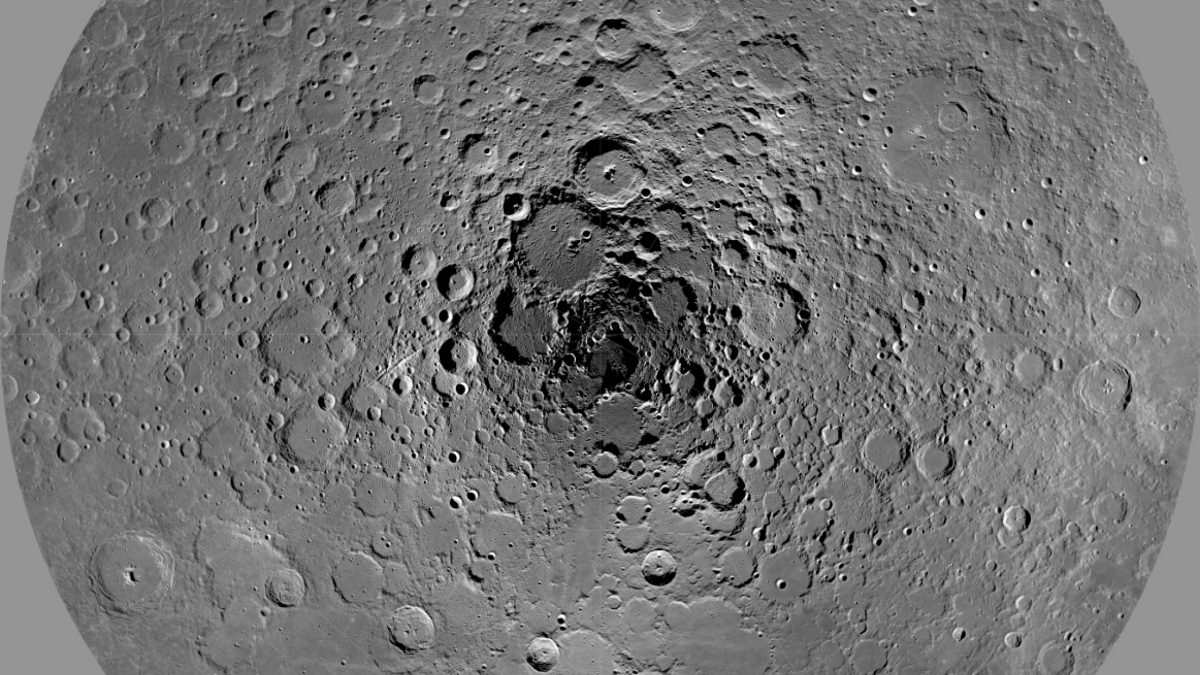Images from ASU’s Lunar Reconnaissance Orbiter Camera featured in new exhibit at Smithsonian’s National Air and Space Museum

The North Pole of the moon. Photo by NASA/Goddard Space Flight Center/Arizona State University
The Smithsonian’s National Air and Space Museum will open its newest exhibition, “A New Moon Rises: New Views from the Lunar Reconnaissance Orbiter Camera,” Feb. 26, displaying dramatic landscapes of the moon captured by Arizona State University’s Lunar Reconnaissance Orbiter Camera (LROC) on NASA’s Lunar Reconnaissance Orbiter spacecraft.
These breathtaking images showcase everything from Apollo landing sites to majestic mountains that rise out of the darkness of the lunar poles. The exhibition will be open through December 2016 at the Smithsonian in Washington, D.C.
Mark Robinson, professor and principal investigator of LROC at ASU’s School of Earth and Space Exploration, partnered with National Air and Space Museum staff members to make the exhibit possible. Robinson’s team includes undergraduate, graduate and post-doctoral students with backgrounds in science, engineering and IT. It is this combination of skill sets and talent that are needed to operate LROC’s high-resolution Narrow Angle Camera and lower-resolution Wide Angle Camera and to produce the images featured in this exhibition.
“To me the LROC images reveal the moon as a mysterious and beautiful place, a whole world just three days away,” said Robinson. “It is my hope that visitors will walk away from the exhibition excited about the moon. Continued lunar exploration will answer many fundamental science questions, provide natural resources and renew our sense of place in the universe. A return to the moon is our pathway to human exploration of Mars and beyond, and LROC is leading the way.”
“A New Moon Rises” is divided into six themes — Global Views, Exploration Sites, Discoveries, Vistas, Topography and Craters. These themes helped to determine which of the thousands of images taken by the LROC would be chosen for display. Visitors will also have the opportunity to see new images from LROC projected on a large screen. The new images will be updated daily. The exhibition includes a display of flight spares of the LROC cameras, and a large 3-D model of a young lunar crater.
The 61 large prints in the exhibition reveal a celestial neighbor that is surprisingly dynamic, full of grandeur and wonder. The more than a million images from LROC are reshaping our understanding of the moon. They reveal newly formed impact craters, recent volcanic activity, and a crust being fractured by the shrinking of a still cooling interior.
“Most people do not realize that the moon is still a very active place, and that it has breathtaking landscapes that are both familiar and alien. All of this is evident from the images LROC has taken and that are displayed in this exhibition,” said Tom Watters, senior scientist at the Smithsonian’s Center for Earth and Planetary Studies and curator of the exhibition.
NASA launched the Lunar Reconnaissance Orbiter in 2009, and the mission is managed by NASA’s Goddard Space Flight Center. Part of its primary mission was to help prepare NASA to send astronauts back to the moon. Its other mission is scientific research, exploring our nearest celestial neighbor in ways never before possible.
The exhibition is made possible by the support of NASA and Arizona State University.
The National Air and Space Museum building on the National Mall in Washington, D.C., is at Sixth Street and Independence Avenue S.W. The museum’s research, collections, exhibitions and programs focus on aeronautical history, space history and planetary studies. The building is open from 10 a.m. until 5:30 p.m. every day (closed Dec. 25).
More Science and technology
2 ASU faculty elected as fellows to National Academy of Inventors
Arizona State University faculty members Bertram Jacobs and Klaus Lackner have been elected as fellows to the National…

Harvesting satellite insights for Maui County farmers
Food sovereignty can refer to having access to culturally significant foods, but Noa Kekuewa Lincoln believes it goes farther…

Google grant creates AI research paths for underserved students
Top tech companies like Google say they are eager to encourage women and members of historically underrepresented groups to…